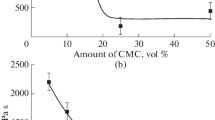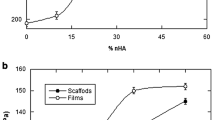Abstract
A new family of polyanhydrides has been developed which can be cured photochemically to produce degradable networks. These degradable polyanhydride networks can be useful in orthopedics as bone cements and for drug delivery. This system, which is a semi-interpenetrating network (semi-IPN), has been evaluated for tissue compatibility in subcutaneous sites in rats and shown to undergo degradation by surface erosion. It was observed that the inflammatory response to the semi-IPN implants was minimal at both short (3, 6 weeks) and long (28 weeks) time points and the fibrotic response was largely absent throughout the duration of this study. Furthermore, excellent tissue infiltration and integration with good neovascularization was observed around the semi-IPN implants. The osteocompatibility and osteoconductive properties of this system have been evaluated in a longitudinal defect model in the articular surface of the distal femur in adult rabbits. This study compared the semi-IPN implants to control groups consisting of unfilled defects and PLA implants. Histological evaluation (H&E and Trichrome Masson staining) of the implant site revealed that the semi-IPN implant is osteocompatible and well tolerated by the surrounding cancellous bone and marrow constituents. The tissue reaction to the implant is characterized by an ingrowth of vascularized connective tissue and a mild fibrous capsule. Furthermore, partial to complete closure of the articular surface with fibrocartilage and fibrous tissue was observed in all experimental animals containing the semi-IPN polymer implants.
Similar content being viewed by others
References
A. Mojola, S. Vainionpää, K. Vihtonen, M. Mero, J. Vasenius, P. Törmälä, and P. Rokkanen, Clin. Ortho. Rel. Res. 268, 260 (1991).
Bone Graft and Bone Substitutes, Eds. M. B. Habal and A. H. Reddi, W. B. Saunders Co., Chp. 26, pg. 276 (1992).
J. Suganuma, H. Alexander, J. Traub, and J. C. Ricci, Tissue Inducing Biomaterials in MRS. Proceedings (1992).
Bone Graft and Bone Substitutes, Eds. M. B. Habal and A. H. Reddi, W. B. Saunders Co., pg. 399 (1992).
L. Savarino, S. Stea, G. Ciapetti, G. Paganetto, M. E. Donati, P. Alvergna and A. Pizzoferrato, J. Biomed. Mat. Res. 29, 701 (1995) and J. Glowacki, M. Jasty, and S. Goldring, J. Bone Miner. Res. 1, 327 (1986)
K. S. Anseth, V. R. Shastri, C. T. Laurencin, and R. Langer, ACS: PMSE 74, 385 (1996).
J. W. Hill andW. H. Carothers, J. Am. Chem. Soc. 54, 1569 (1932).
H. G. Rosen, J. Chang, G. E. Wnek, R. Linhardt, and R. Langer, Biomaterials 4, 131 (1983). and A. Domb and R. Langer, J. Polym. Sci. 23, 3375 (1987).
V. Shastri, R. P. Marini, J. Lindberg, P. Tarcha, and R. Langer, Manuscript in preparation.
Author information
Authors and Affiliations
Corresponding author
Rights and permissions
About this article
Cite this article
Shastri, V.R., Marini, R.P., Padera, R.F. et al. Osteocompatibility of Photopolymerizable Anhydride Networks. MRS Online Proceedings Library 530, 93–98 (1998). https://doi.org/10.1557/PROC-530-93
Published:
Issue Date:
DOI: https://doi.org/10.1557/PROC-530-93




